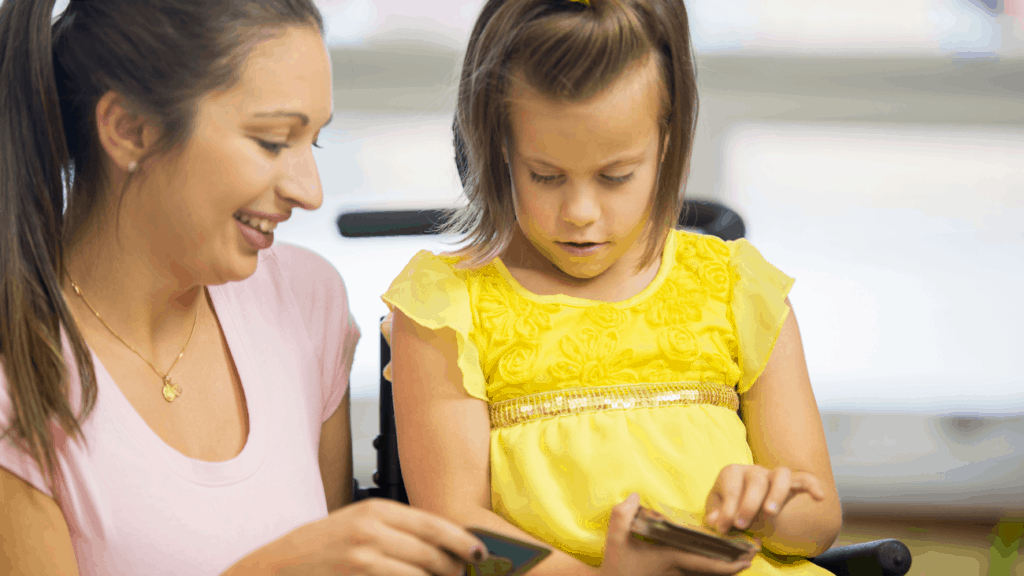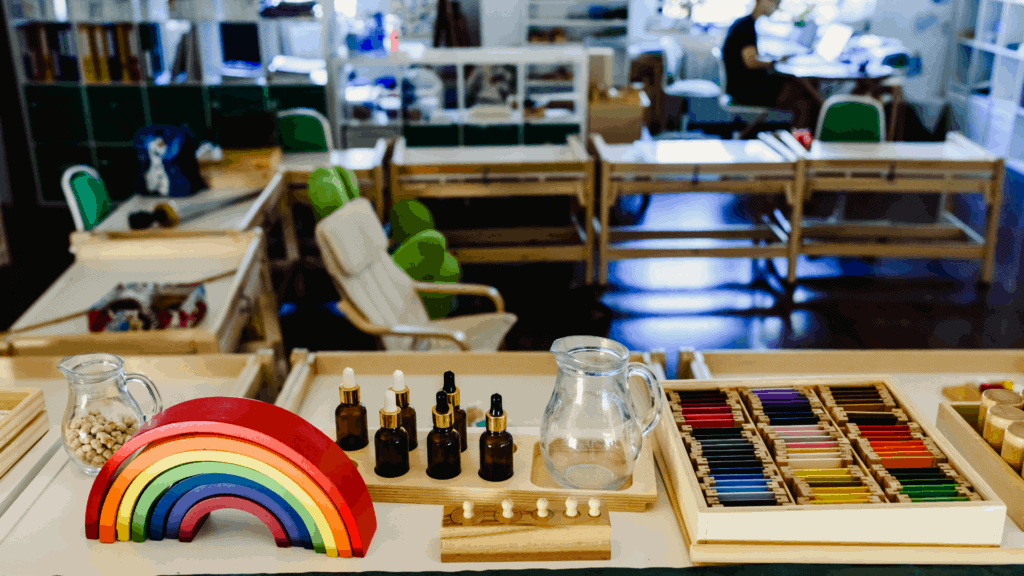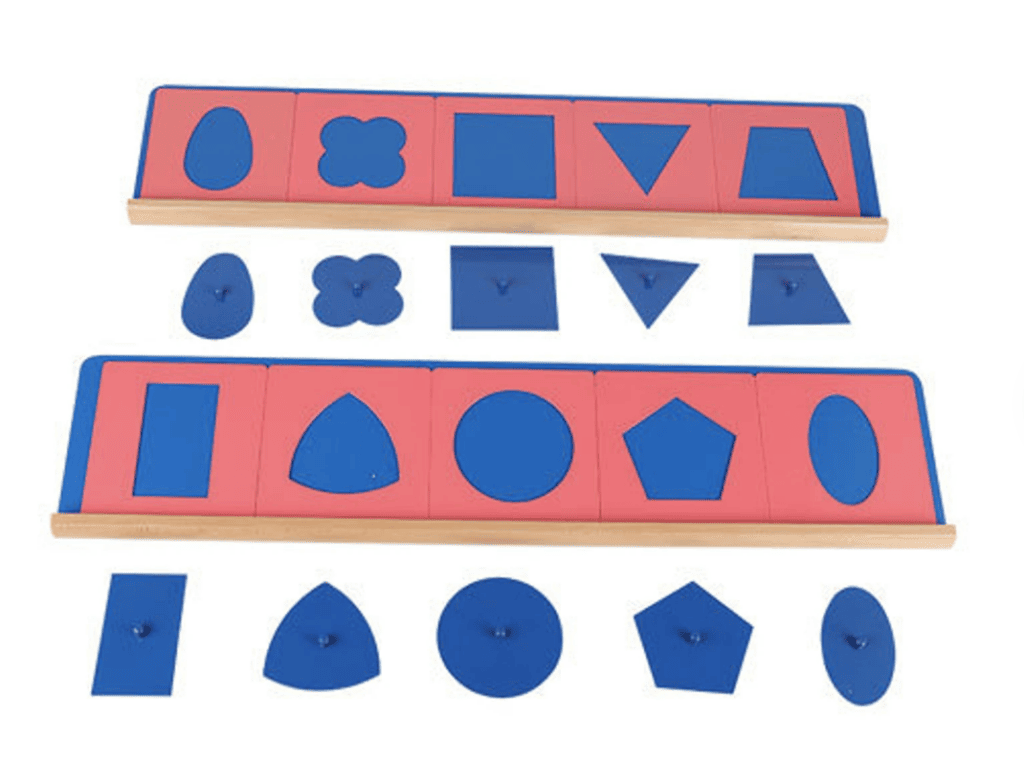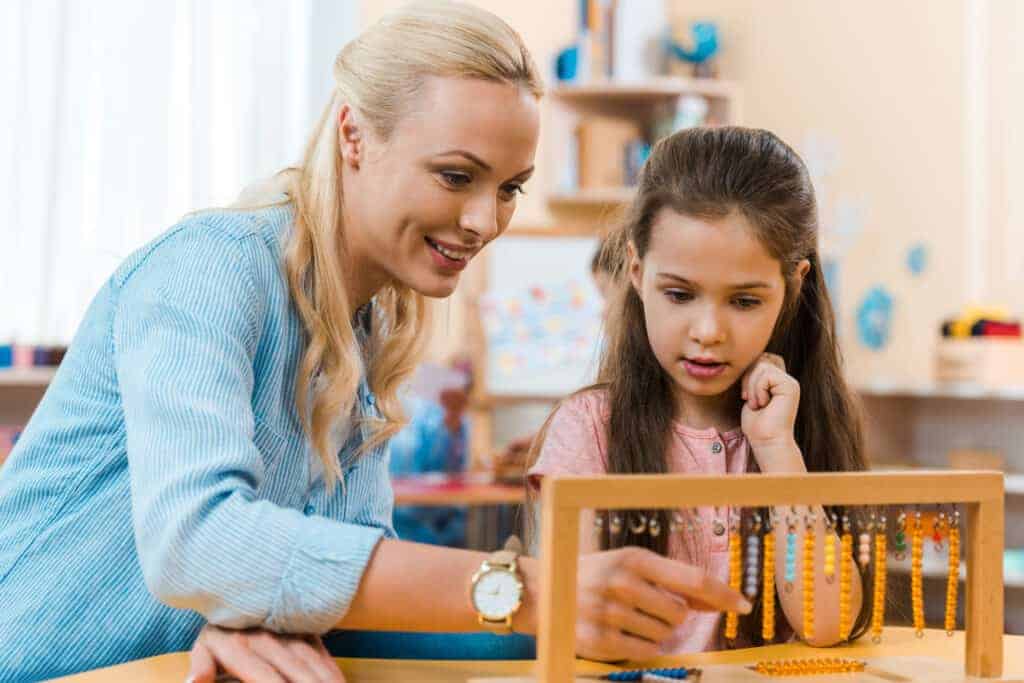
Montessori teaching is a great way to engage with students in every content area. Because math is a subject that is harder for students to learn independently, the
The
Along with set directions on how to use the
Colored Bead Stairs
The Colored Bead Stairs are a strategy to visually show the quantity of a number, connect that quantity to a name, and connect the name to a written symbol. Additionally, they can be used to introduce your student to the concept of “teen” numbers (11-19).
Colored Bead Stairs are beads that are linked together to represent numbers 1-10. When they are stacked vertically, they look like stairs or a pyramid, hence the name.
Understanding the Quantity of a Number
Basic:
- Place the bars of beads randomly in front of the student.
- Pick up the first bar with one singular bead on it and place it away from the others.
- Point at the bead and say “this is one.”
- Then, pick up the second bar with two beads on it and place it underneath the first bar.
- Point at the second bar of beads and say “this is two.” Have the student count the first bead on that bar as “one” and the second as “two.” Explain that since the two beads are together, the whole bar is “two.”
- Repeat this process for each layer of the Colored Bead Stair.
Additional Variations After Completing The Basic Use:
- Place the bars of beads randomly in front of the student.
- Ask the student to give you a specific bar by placing it in front of you. For example, say “will you please give me five.”
- When the student puts the bar down in front of you, ask the student to count the beads to verify it was the correct bar.
- When the student has given you all ten bars, ask the student to place them in order of 1-10 to make the stairs.
- Ask the student to point to each bar (in the correct order of 1-10) and say the number.
Or
- Place the bars of beads randomly in front of the student.
- Pick up a bar and ask the student “what is this.”
- The student will count each bead in that bar and tell you the number.
- Repeat this for each bar.
- Ask the student to place the bars in order of 1-10 to make the stairs.
- Ask the student to point to each bar (in the correct order of 1-10) and say the number again.
Or
- Place the bars of beads randomly in front of the student.
- Ask the student to pick a bar and tell you the name.
- Ask the student to count the beads to verify they said the right name.
- Repeat this for each bar.
- Ask the student to place the bars in order of 1-10 to make the stairs.
- Ask the student to point to each bar (in the correct order of 1-10) and say the number again.
Recognizing The Written Symbol for A Number
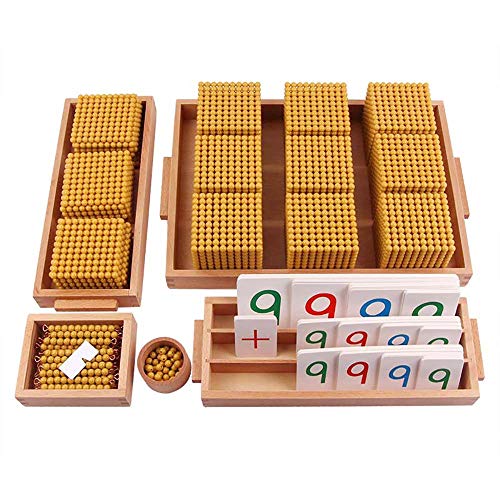
Basic:
- Place numbered cards vertically in order of 1-10 on one side of the work area and place the Colored Bead Stair vertically in order of 1-10 on the other side of the work area.
- Take the first layer of the stairs and place it in the middle of the work area.
- Ask the student “what is this?”
- Move the bead next to the number card that says “1.”
- Tell the student “this is how we write one.”
- Trace the one with two of your fingers and repeat “this is one.”
- Have the student replicate your tracing of the number and say “this is one.”
- Repeat this process for each of the bars.
- For 2-10, ask the student to count the beads on each bar after learning the written symbol.
Additional Variations After Completing the Basic Use:
- Place numbered cards vertically in order of 1-10 on one side of the work area and place the Colored Bead Stair vertically in order of 1-10 on the other side of the work area.
- Have the student match each layer of the Colored Bead Stair to the right number card.
- Ask the student to count each bead when they match the bar to the number.
Teaching Students 11-19
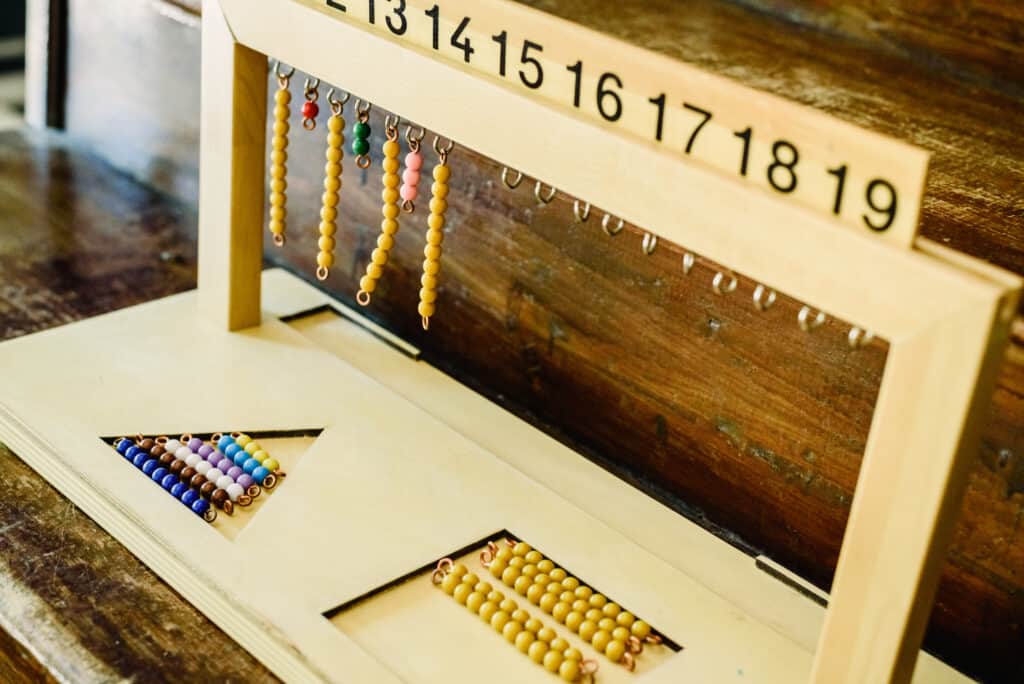
Basic:
- Place numbered cards vertically in order of 1-9 on one side of the work area and place the Colored Bead Stair vertically in order of 1-9 on the other side of the work area.
- Place the number 10 card in the middle of the work area.
- Somewhere on the side by the Colored Bead Stair, place a pile of nine “10” bars.
- Ask the student to take one of the “10” bars and placing it next to the number 10 card in the middle.
- Ask the student to take the first layer of the Colored Bead Stair ( “1” bar) and place it next to the “10” bar in the middle.
- Count each of the beads up to ten together.
- Point to the singular bead and say “and one more is eleven.”
- Place the number 1 card on top of the number 10 card in the middle so that the “1” is covering up the “0” and making “11.”
- Point to the new number 11 card and say “this is how we write eleven.”
- Repeat this process with each of the bars in the Colored Bead Stair to make 11-19.
Additional Variations After Completing the Basic Use:
- Put down the number cards to make one of the numbers between 11-19.
- Ask the student “what is this?”
- Ask the student to show how many beads are in that number by grabbing a “10” bar and the corresponding bar from the Colored Bead Stair.
- Repeat this for each number in 11-19.
Or
- Say a number between 11-19.
- Ask the student to put down the number cards to make the symbol for that number.
- Ask the student to show how many beads are in that number by grabbing a “10” bar and the corresponding bar from the Colored Bead Stair.
- Repeat this for each number in 11-19.
Or
- Place beads in front of the student that represents a number between 11-19.
- Ask the student “what number is this?”
- Ask the student to put down the number cards to make the symbol for that number.
- Repeat this for each number in 11-19.
Or
- Have the student independently practice arranging 11-19 in order and counting the beads for each number.
Golden Bead Materials
The Golden Bead Materials are sets of individual golden beads, bars of ten beads, squares of 100, and cubes of 1000. This strategy is to help the student learn higher numbers and understand places.
Learning Tens (20-1000)
- Place down a mat that is split into four sections.
- In the right-most section, have the student place individual beads representing 1-9 vertically (with one being at the top).
- When you reach nine, ask the student “what comes next?”
- Tell the student “we need to get a ’10’ bar instead of ten individual beads. Then, we need to move to a new place.”
- Have the student place the ’10’ bar at the top of the inner-right section.
- Horizontally in line with the individual units the student made, have the student place the same amount of ’10’ bars going vertically down their new section.
- As the student places down each amount of ’10’ bars, tell the student what that number is called. For example, “two ’10’ bars are called twenty.” *Pointing at the bars* “This is twenty.”
- When you get to 90, tell the student “the next set would be ten ’10’ bars, but like the last section we are going to move to a new place with a bigger tool. Ten ’10’ bars are called 100. We need to get a hundred square and then move to a new place.”
- Have the student place the hundred square at the top of the inner-left section.
- Have the student place the hundred squares down that section as they did with the “10” bars.
- As the student places down each amount of hundred squares, tell the student what that number is called. For example, “two hundred squares is called two hundred.” *Pointing at the squares* “This is two hundred.”
- When you get to 900, tell the student “the next set would be ten hundred squares, but like the other sections we are going to move to a new place with a bigger tool. Ten hundred squares are called 1000. We need to get a thousand cube and then move to a new place.”
- Have the student place the thousand cube at the top of the left-most section.
- Repeat the process that you did for “10” bars and hundred squares for the thousand cubes.

Learning Each Number 20-1000
- Start with the setup from learning the tens in 20-1000.
- Grab the two “10” bars and ask “what is this?”
- Place them away from everything else.
- Grab the bead representing “1” and place it next to the two “10” bars.
- Count each of the beads up to twenty together.
- Point to the singular bead and say “and one more is twenty-one.”
- You can repeat this process to teach any number up to 1000.
Learning To Solve Math Equations
Here is an example of how to use the Golden Bead Materials to teach a student addition. Using these same procedures you can teach the student subtraction and multiplication as well:
- Ask your student to grab the numeral cards for a four-digit number. For example, 1532.
- Have them place the numeral cards on their desk in order (1000, 500, 30, 2).
- Ask the student to grab the golden bead quantities for those numbers and place them above their corresponding numeral cards.
- Ask the student to grab the numeral cards for another four-digit number. For example, 3265.
- Have them place the numeral cards on their desk in order (3000, 200, 60, 5).
- Ask the student to grab the golden bead quantities for those numbers and place them above their corresponding numeral cards.
- Ask the student to explain how the quantities represent the numbers. If they are confident in their understanding, proceed to teach them addition.
- Have the student move the numeral cards to the right side of their quantities and layer the cards so they read the four-digit amount (1532 and 3265).
- Place a string/ribbon/draw a line underneath everything to make your equal sign.
- Explain “we have two rows here, one with 1532 and the other with 3265. We are going to put them together into one row at the bottom. When we put numbers together, it is called addition because we are adding the numbers together. When we add numbers, we always start with the right side first.”
- Starting with the unit beads, have the student bring all of them under the equal sign.
- Ask the student to count how many beads there are (7).
- Have the student grab a “7” numeral card to place on the right side of the quantity.
- Have the student bring all of the “10” bars under the equal sign.
- Ask the student to count the bars (9).
- Have the student grab a “9” numeral card to place in front of the “7” numeral card.
- Have the student move all of the hundred squares under the equal sign.
- Ask the student to count how many hundred squares there are (7).
- Have the student grab another “7” numeral card to place in front of the “9” numeral card.
- Have the student move all of the thousand cubes under the equal sign.
- Ask the student to count how many thousand cubes there are (4).
- Have the student grab a “4” numeral card to place in front of the “7” numeral card.
- Point to the new four digits (4797) and say “this is the number we get when we add *point to 1532 and 3265* these numbers together. When we moved all of the quantities under *point to the line* this line, we were showing that we were adding them together.”
- (From previous lessons about larger numbers, the student should understand how place values work and should not be confused as to why their new number is not 4000700907. If they are confused, take this time to explain place values with the numeral cards.)


